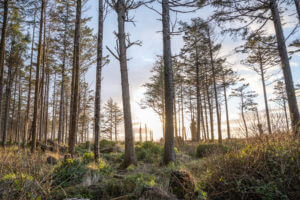Chassis
Whenever you hear a camper van owner talk about the chassis of their vehicle, they’re referring to its frame or support structure. This is the part of the van that bears all the stresses. It holds the engine, supports passengers and luggage, and is crucial to performance and safety.
If you’re traveling with a handful of people or have lots of gear to store, you’ll likely want a van that has a larger chassis.
When you rent with GoCamp, our team will help answer any questions about your camper van’s chassis to choose the model that best fits the needs of your trip.
Wheelbase
The wheelbase of a camper van is the horizontal distance between the centers of its front and rear wheels. This can give you a good idea of how much interior space there is in the van.
Short wheelbase camper vans have a typical wheelbase of 18’ to 19’, while long wheelbase vans range from 20’ to 22’.
Shore power
Shore power is commonly used when referring to ships and boats plugging into the AC electrical grid or main supply. It’s also used when RV owners and vanlifers need to charge up their rigs.
Using shore power, or plugging your van into the electrical outlet in the campground, is especially handy when you want to run anything electrical in your camper van, like the AC, kitchen appliances, or lights. When you use the shore power to power things you aren’t draining the battery, which is important if you were going to do something like boondocking.
Boondocking
For some camper van enthusiasts, boondocking—also known as dispersed camping—is the ideal setup. This means being fully off the grid, with little to no amenities and no electric hookups, water, or dump tanks.
If you enjoy the road less traveled and want to avoid paying campsite fees, boondocking could be perfect for you. Just be sure your camper van is fully stocked with everything you need before you head off into the middle of nowhere.
Inverter
Simply put, an inverter converts DC (direct current) power into AC (alternating current) power. AC power can’t be stored but DC power can. The inverter takes the power stored in your camper’s batteries and makes it usable for things like appliances, USB outlets, and fans.
Living in a van for any period of time usually requires a solid inverter, especially if you go boondocking and otherwise aren’t plugging into a campground’s shore power.
Gray Water
The next time you wash the dishes, pay attention to the color of the leftover water. It’ll likely be some shade of gray. That’s where gray water gets its name.
Gray water refers to all the water used in your camper van, except for the toilet. So any shower water, dishwater, or laundry water that hasn’t been contaminated with waste.
Campgrounds will often have dedicated areas where you can dump gray water. If you’re boondocking, you’re typically allowed to dump your gray water on the ground. Double check the rules before you dump your gray water and make sure there isn’t any solid waste in the water.
Black Water
Black water is the human wastewater that must be kept in its own tank and disposed of properly.
If you rented a camper van with a toilet, expect to empty the black water tank before leaving any campgrounds. Use designated dump stations at the parks and campgrounds.
But what about when you’re boondocking? While gray water can often be dumped on the ground when you’re boondocking, that’s not an option with black water. As you hit the road, find an interstate rest stop or truck stop where you can dump your waste.
Outfitter
An outfitter is a person, shop, or company that specializes in the design and construction of camper vans. GoCamp is proud to be the only peer-to-peer camper van rental company that offers the option to search vans by builder. Head to the Try Before You Buy page for more information.
BLM
The Bureau of Land Management (BLM) is a federal agency that manages over 240 million acres of land in the United States, and offers lots of opportunities for camping.
Most BLM land is free to camp on with no need for reservations. This includes national parks, developed recreation areas, and open lands. Wilderness areas are often also open to camping but can come with some restrictions.


